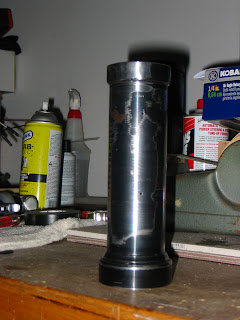You may notice in the photo that you're looking at the OTHER side of the bike. Normally I have it up against the wall and you see the left (or kickstand side) of the bike... more on that later...
The down tube was my hardest fabrication project yet. I had to roll the tubing in one direction to get one curve, then flip it and gently work in the "re-curve". It's almost impossible to do this perfectly with the roller I have. And, it's not perfect, but at least I have the profile I wanted. On an expensive, computer controlled roller this could be done, but you don't want to know how much that costs... Anyway, I'm pretty happy with it. The next hardest part of fabbing this tube then became cross-drilling the "piercing tube" holes for the front engine mounts. Lots of fitting/re-fitting on the drill press to make sure everything was exactly perpendicular to the bends in the tubing. Again, really hard on the equipment I have, but doable.
So, overall this frame is exactly what I had designed so far. The rear triangle is still in the design stage, but probably 85% done. When this thing becomes a roller, I'll be really excited! There is WAY more to consider when figuring out the rear end, and a real challenge in trying to visualize / carry out a 2-dimensional drawing into 3 dimensional space...
Which brings me to my introspective look at the end of year 2...
I wanted to pull the bike away from the wall and into the center of the garage. I haven't done that yet, and I was excited to walk around the bike and look at it from other angles / sides. By doing that, I was able to stand far away and look at the lines. I could look at the back of the bike from a distance and sight the line of the backbone from the rear wheel up to the steering tube...
...and that's when I noticed it.
In my 2-dimensional design world, everything is absolutely perfect. I have lengths, widths, angles, and radii all precisely plotted out. Rake and trail dimensions have all been worked out by complicated sine-cosine tangent equations. (who says I'm no good at math?) This is all awesome, and necessary to create a machine that will place one wheel exactly in line with the other, and will handle better than a shopping cart.
My BIGGEST challenge is to be as accurate as I can when turning a perfect drawing into a real thing. Steel is real. Bending tubing is real. Drilling holes and machining parts is real. It's easy to use a computer for creating exact parts, but my hands and brain aren't a computer. My eye doesn't see that 3rd dimension so well. My tubing roller has some play in it. My drill press may have a slight run-out. My build platform may not be perfectly level where it sits up against the wall.
All these things have micro (and compounding) effects on each other and everything else. It's kinda like math... Say you're studying algebra and you don't quite understand something. Next week, your teacher moves on to the next section and you don't understand that either... or the section after that. You need to understand it all, and make sure it's perfect before you can move on.
I have some areas on my bike that need (or have needed) attention since day one. It's just that now I'm able to see the issues now that I have some frame tubing done. It was impossible for me to know back then that I needed to spend more time making sure things were level / perpendicular / measured more accurately before moving on.
What I need to do is not that bad, and I'm thankful I was able to see it now so I can fix it. I have pretty high standards for this kind of stuff and I can't just let it go. At first, I felt kind of defeated like this project was spinning itself out of control, but it's really not. It's just a reminder that there is a human directing this project.
There is a quote by Theodore Roosevelt Jr. that came to mind when I was kind of depressed about my inaccuracies... I've pasted it below. It kinda pulled me out of my funk yesterday. I WILL see this project to completion, and like I've said the whole time... I'm learning more about design, fabrication, and manufacturing each time I enter my "parallel universe" (garage). I'm doing it the hard way, but when I look at where I've come from to where I am now, I wouldn't have changed anything.
It is not the critic who counts; not the man who points out how the strong man stumbles, or where the doer of deeds could have done them better. The credit belongs to the man who is actually in the arena, whose face is marred by dust and sweat and blood; who strives valiantly; who errs, who comes short again and again, because there is no effort without error and shortcoming; but who does actually strive to do the deeds; who knows great enthusiasms, the great devotions; who spends himself in a worthy cause; who at the best knows in the end the triumph of high achievement, and who at the worst, if he fails, at least fails while daring greatly, so that his place shall never be with those cold and timid souls who neither know victory nor defeat.
Theodore Roosevelt
April 23, 1910




















































